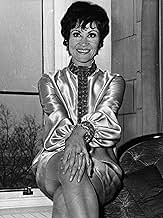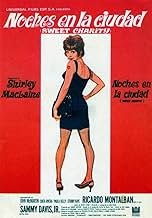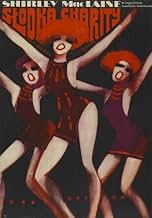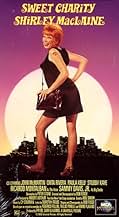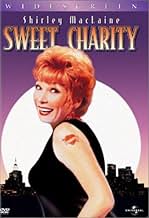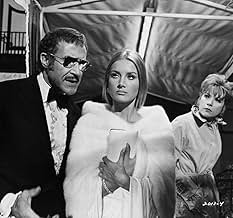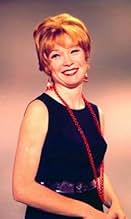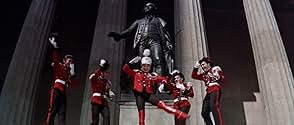Unter der Regie von Musical-Legende Bob Fosse (,Cabaret') singt und tanzt Superstar Shirley MacLaine (,Das Mädchen Irma La Douce') sich in dieser Verfilmung des gleichnamigen Broadway-Hits d... Alles lesenUnter der Regie von Musical-Legende Bob Fosse (,Cabaret') singt und tanzt Superstar Shirley MacLaine (,Das Mädchen Irma La Douce') sich in dieser Verfilmung des gleichnamigen Broadway-Hits durch eine ihrer besten Rollen!Unter der Regie von Musical-Legende Bob Fosse (,Cabaret') singt und tanzt Superstar Shirley MacLaine (,Das Mädchen Irma La Douce') sich in dieser Verfilmung des gleichnamigen Broadway-Hits durch eine ihrer besten Rollen!
- Für 3 Oscars nominiert
- 6 Nominierungen insgesamt
- Charlie
- (as Dante D'Paulo)
- Dancer
- (Nicht genannt)
Empfohlene Bewertungen
Coming back to the original tragic comedy "Nights of Cabiria", of all the characters Fellini had given life on screen, by his own words, Cabiria was the only one he worried about many years after the film was made. Of all the characters, I've seen in films, Cabiria is the one I often think about - whatever happened to her? Did she survive? Was she able to find love? As much as I like Shirley MacLaine/Charity, I did not worry about her future. She lived happily ever after - in both movie endings, theatrical and alternative.
MacLaine plays Charity Hope Valentine, a sweet but rather clueless woman who works in a dance hall but yearns for love. She's constantly linking up with men who use her, take her money, dump her. The film opens with Charity in Central Park with her "boyfriend." Sitting on a bridge, she chirps about making a wish and throwing something off the bridge. The creep shoves her into the water.
She has two wiser-but-cynical pals, played by Chita Rivera and Paula Kelly. They seem resigned to their fates as dance hall girls but there's still an ember of hope for a better life.
Charity meets an Italian film star (Ricardo Montalban) and spend the night with him ... in his closet. She then meets a repressed man (John McMartin) in a stalled elevator and seems to have found happiness at last..... But is happiness in the cards for Charity? MacLaine seems to channel Gwen Verdon (who starred in the show on Broadway and who worked with MacLaine on the dance numbers) and excels in the many productions numbers, especially "If They Could See Me Now" and "Somebody Loves Me at Last." MacLaine also has a spirited rooftop dance number with Rivera and Kelly as they opine "There's Gotta Be Something Better Than This." The show-stopper is probably the "Big Spender" number which features MacLaine, Rivera, and Kelly with a line of dance hall girls who try to lure men to be their partners. It's a sensational number that shows Bob Fosse's choreographic skills and also demonstrates the cynical life of a dance hall girl.
Other great numbers include MacLaine and Montalban's visit to the Pompeii Club where the dancers go through a series of landmark Fosse dances. The lead dancer here is the sensational Suzanne Charny. Among the dancers are also Ben Vereen, Lee Roy Reams, and Chelsea Brown.
Sammy Davis turns up the heat with the "River of Life" number which shows Charity and Oscar (McMartin)seeking meaning and discovering the 60s counter culture. Then there's Stubby Kaye as the dance hall manager who throws Charity a wedding party and sings "I Love to Cry at Weddings." This is a hugely underrated musical filled with great music and production numbers. Big, bright, brassy, and brazen, what's not to love? MacLaine won a Golden Globe nomination.
The dull non-musical scenes are a chore to sit through, but when one of Fosse's amazing production numbers begins, Sweet Charity soars into the sublime. Fosse was quite simply a genius, and the great showcase numbers such as "Hey Big Spender" and "Rich Man's Frug" are as brilliant as any dance numbers ever put on film.
Shifting configurations of dancers, contorted body poses, dance steps that are by turns awkward and graceful, a studied contrast between clustering dancers and separating dancers -- it is hard to describe the magic of the Pompeii Club sequence. I've always felt that Fosse's choreography has the same sense of space and volume as Cubist painting.
Fosse's camera placement and camera movement capture an ideal "in-the-round" feeling of choreographed numbers that one cannot experience in the theater. For a first-time film director, Fosse revealed an amazing facility for the form. Usually theater directors don't take to the medium of film as quickly as Fosse did. Usually, theater directors make visually unexciting films that feel stage-bound. Not Fosse -- Sweet Charity, despite some flaws, doesn't play like a filmed stage play, it has the visual panache of Fellini and Godard.
Sweet Charity was just a warm-up, Fosse's personal film school at Universal's expense, before he truly mastered the form of film-making with the classic Cabaret.
Wusstest du schon
- WissenswertesAlthough uncredited, Gwen Verdon was assistant choreographer in the film version of Sweet Charity (1969).
- PatzerIn the "Aloof" movement of "The Rich Man's Frug," two of the male principal dancers walk down the stairs to light a woman's cigarette, while the others dance behind them. The background choreography in this shot leads directly to the triangle formation of the next shot, and the two men are now in the middle of the group, although there was no time for them to reach that position.
- Zitate
Charity Hope Valentine: Wow! This place sure is crawlin' with celebrities. I'm the only person here I never heard of.
- Alternative VersionenLaserdisc version contains an alternative ending. After Oscar leaves Charity, he starts to go crazy in his apartment. He then realizes that despite Charity's faults, he really can't live without her. He finds Charity on the bridge in Central Park and, thinking she's going to jump, falls into the river. Charity jumps in after Oscar and forgives him. The two then walk off together, soaking wet, through the park. Bob Fosse thought this ending was too corny, and decided to use the depressing, yet more inspirational, ending for the film's major release.
- VerbindungenFeatured in Sweet Charity: From the Stage to the Screen (1969)
- SoundtracksMy Personal Property
(uncredited)
Music by Cy Coleman
Lyrics by Dorothy Fields
Performed by Shirley MacLaine
Top-Auswahl
- How long is Sweet Charity?Powered by Alexa
Details
- Erscheinungsdatum
- Herkunftsland
- Sprache
- Auch bekannt als
- Sweet Charity: The Adventures of a Girl Who Wanted to Be Loved
- Drehorte
- Produktionsfirma
- Weitere beteiligte Unternehmen bei IMDbPro anzeigen
Box Office
- Budget
- 20.000.000 $ (geschätzt)
- Laufzeit2 Stunden 29 Minuten
- Seitenverhältnis
- 2.35 : 1


